Importing and Using your Email or Personal Authentication certificate with Outlook Express 5 & 6
-
If you originally applied for the certificate on the same computer as your Outlook Express installation then it should already be installed. You can skip straight to 'Signing and Encrypting'.
-
If your certificate is not already installed on the computer you are using, then please export it from the machine on which it resides using one of the browsers listed on the CPAC main page. You then need to transfer it to this computer (email it to yourself or save the certificate file to USB then copy over). You can then follow the 'import' instructions in this document.
Importing your Certificate into Outlook Express 5 / 6:
-
Open Outlook Express and click 'Tools' > 'Options'.
-
Select the 'Security' tab and then click the 'Digital IDs' button.
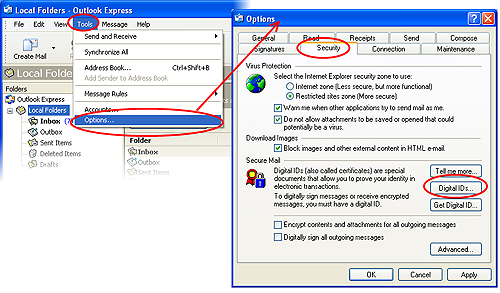
-
In the Certificates interface, make sure the 'Personal' tab is selected, click 'Import' and then click 'Next'.
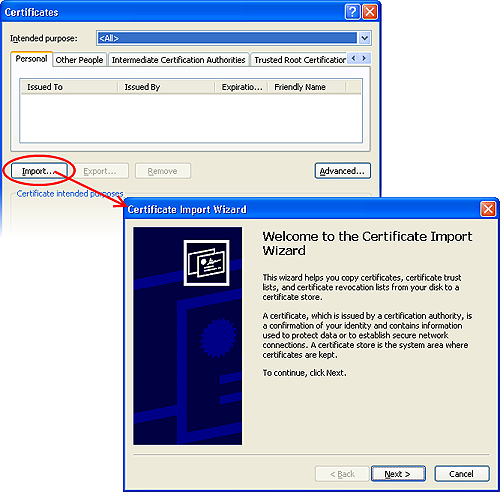
-
Click 'Browse' in the next step and navigate to the location of your PKCS12 certificate file.
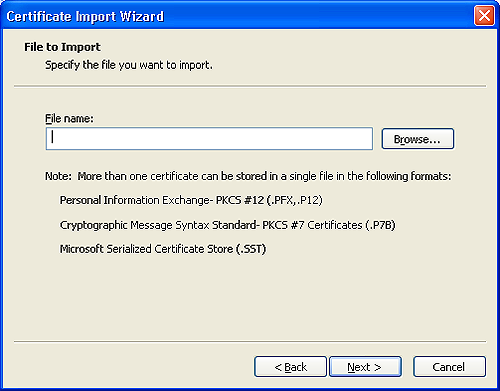
-
Now you need to change type of the file, select 'Personal Information Exchange (.p12)' from the drop down box, locate your certificate file (.p12) and click 'Open' (see below).
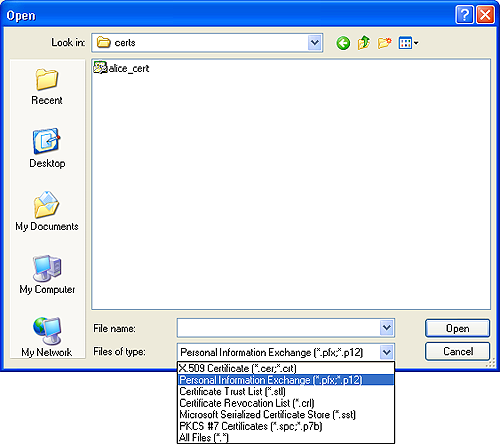
-
Click Next. To complete the installation process, you are required to enter the PIN (password) you set up for the certificate during the enrollment process. If you have forgotten your password, contact your system administrator who will be able to reset it for you.
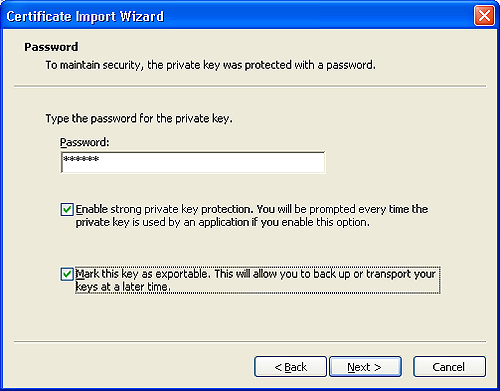
-
Click Next. You will be prompted to choose the certificate store for your certificate. Unless your administrator has specified otherwise, you should leave this at the default Place all certificates in the following store option.
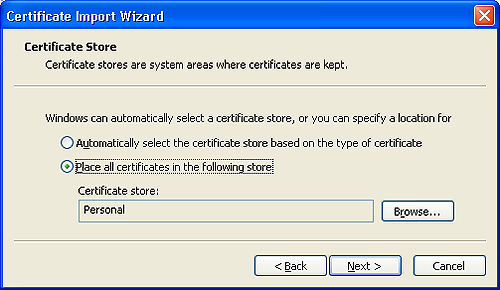
-
Click 'Next'.
-
The last step: completing the Certificate Import Wizard.
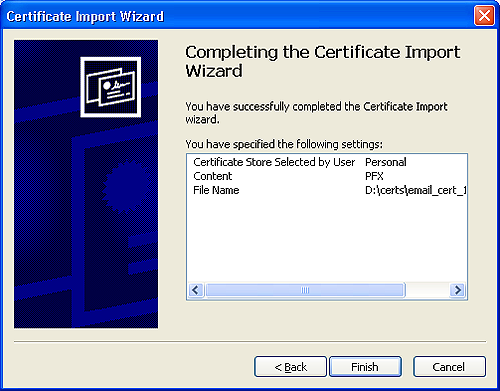
-
Click Finish to complete the process. The certificate will be imported.
-
Select the security level for storing the Private Key in your system and click OK.
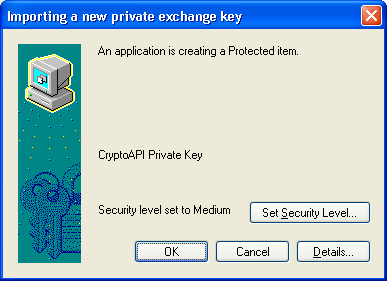
That's it. You have successfully imported your Comodo Personal Authentication certificate.
Signing and Encrypting Mails
-
Signing an email ensures the recipient knows the email has come from you and informs them that it has not been modified in transit.
-
Encrypting an email ensures that only the recipient can read the email content and attachments.
Note: In order to encrypt mail, you must first have your recipient’s email certificate in your certificate store. To obtain their certificate, you need to get your contact to send you a signed email. Upon receipt of the signed mail, their certificate will be automatically imported into your certificate store and you will be able to sign/encrypt mail to that person.
Assign the certificate
-
Open Outlook Express then click 'Tools' > Accounts...'.
-
In the Internet Accounts screen, select the 'Mail' tab and then select the email account that you want to assign the certificate.
-
Click Properties then select the Security tab:
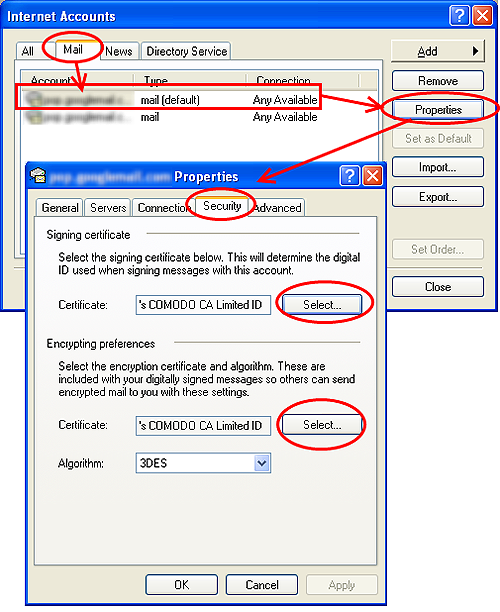
-
Click 'Select' beside the text box in the 'Signing certificate' area and select your Comodo Personal Authentication certificate in the 'Select Digital ID' screen.
-
Click 'Select' beside the text box in the 'Encrypting preferences' area and select the same certificate for Encryption by clicking OK in the 'Select Digital ID' screen.
-
Click 'Apply' and 'OK' to assign the certificate.
Signing and Encrypting Mails
Signing and encrypting individual mails:
To sign mail:
-
Compose your email and attach files as usual
-
Click the Sign
 button in the tool bar.
button in the tool bar. -
Click Send.
To encrypt mail:
-
Compose your email and attach files as usual
-
Ensure the recipient has a Digital Certificate and you have assigned the Certificate to their entry in your OE address book
-
Click the Encrypt
 button.
button. -
Click Send.
Signing and Encrypting all mails by default:
-
Open Outlook Express and select Tools > Options...
-
In the Options interface, select the Security tab and check one or both of the Encrypt contents and attachments for all outgoing messages and Digitally sign all outgoing messages check-boxes.
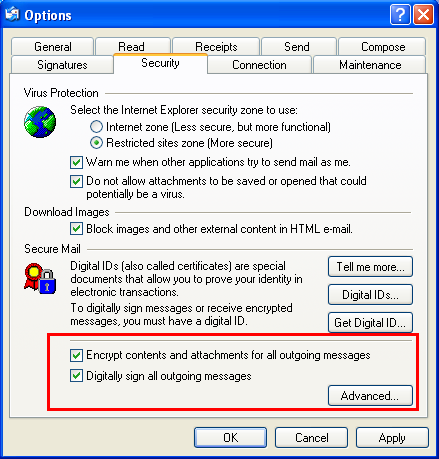
-
Click 'Apply' then 'OK'.
Adding senders' Certificate to your address book:
In order to automatically add senders' certificates to your address book:
-
Select Tools > Options...
-
In the Options interface, select the Security tab and click 'Advanced'.
-
In the Advanced Security Settings screen, check (place a tick in) Add Senders Certificates to my address book checkbox.
All incoming signed emails will add the sender's certificate to your address book

